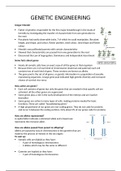Summary
Summary Grade 12 Biology: Genetic Engineering
- Course
- Matric
- Institution
- St Stithians College (Stithian)
An in-depth summary of Genetic Engineering for IEB matrics. These notes include the roles of important people, a thorough summary of genes and their alleles, how to complete a Punnet square and the role of dominant and recessive genes, sex chromosomes and their diseases, and the methods of genetic ...
[Show more]



